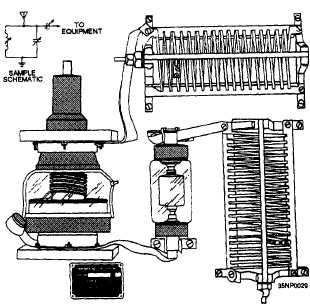Figure 2-37.—Matching network.
the tuner, assembling the connections with the antenna
and transmission line, and pressurizing the tuner,
if necessary. Access must be provided to the pressure
gauge and pressurizing and purging connections.
ANTENNA TUNING
For every frequency in the frequency spectrum,
there is an antenna that is perfect for radiating at that
frequency. By that we mean that all of the power
being transmitted from the transmitter to the antenna
will be radiated into space. Unfortunately, this is the
ideal and not the rule. Normally, some power is lost
between the transmitter and the antenna. This power
loss is the result of the antenna not having the perfect
dimensions and size to radiate perfectly all of the
power delivered to it from the transmitter. Naturally,
it would be unrealistic to carry a separate antenna for
every frequency that a communications center is
capable of radiating; a ship would have to have
millions of antennas on board, and that would be
impossible.
To overcome this problem, we use ANTENNA
TUNING to lengthen and shorten antennas electrically
to better match the frequency on which we want to
transmit. The rf tuner is connected electrically to the
antenna and is used to adjust the apparent physical
length of the antenna by electrical means. This simply
means that the antenna does not physically change
length; instead, it is adapted electrically to the output
frequency of the transmitter and “appears” to change
its physical length. Antenna tuning is done by using
antenna couplers, tuners, and multicouplers.
Antenna couplers and tuners are used to match
a single transmitter or receiver to one antenna whereas
antenna multicouplers are used to match more than
one transmitter or receiver to o n e antenna for
simultaneous operation. Some of the many antenna
couplers that are in present use are addressed in the
following paragraphs. For specific information on
a particular coupler, refer to the appropriate equipment
technical manual.
Antenna Coupler Group AN/URA-38
Antenna Coupler Group AN/URA-38 is an
automatic antenna tuning system intended primarily
for use with the AN/URT-23(V) operating in the
high-frequency range. The equipment also includes
provisions for manual and semiautomatic tuning,
making the system readily adaptable for use with other
radio transmitters. The manual tuning feature is useful
when a failure occurs in the automatic tuning circuitry.
Tuning can also be done without the use of rf power
(silent tuning). This method is useful in installations
where radio silence must be maintained except for
brief transmission periods.
The antenna coupler matches the impedance of
a 15-, 25-, 28-, or 35-foot whip antenna to a 50-ohm
transmission line, at any frequency in the 2-to 30-MHz
range.
When the coupler is used with the
AN/URT-23(V), control signals from the associated
antenna coupler control unit automatically tune the
coupler’s matching network in less than 5 seconds.
During manual and silent operation, the operator uses
the controls mounted on the antenna coupler control
unit to tune the antenna. A low-power (less than 250
watts) cw signal is required for tuning. Once tuned,
the CU 938A/URA-38 is capable of handling 1000
watts PEP.
Antenna Coupler Groups
AN/SRA-56, -57, and -58
Antenna coupler groups AN/SRA-56, -57, and
-58 are designed primarily for shipboard use. Each
2-21


